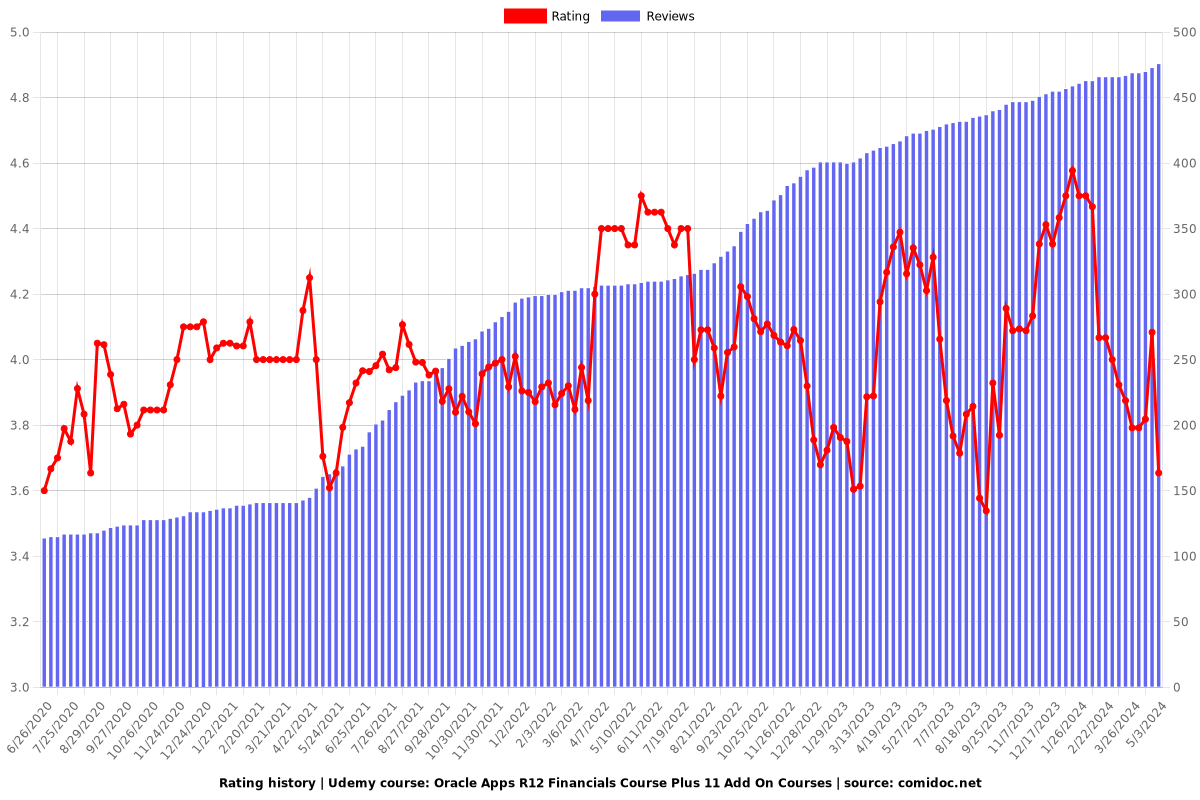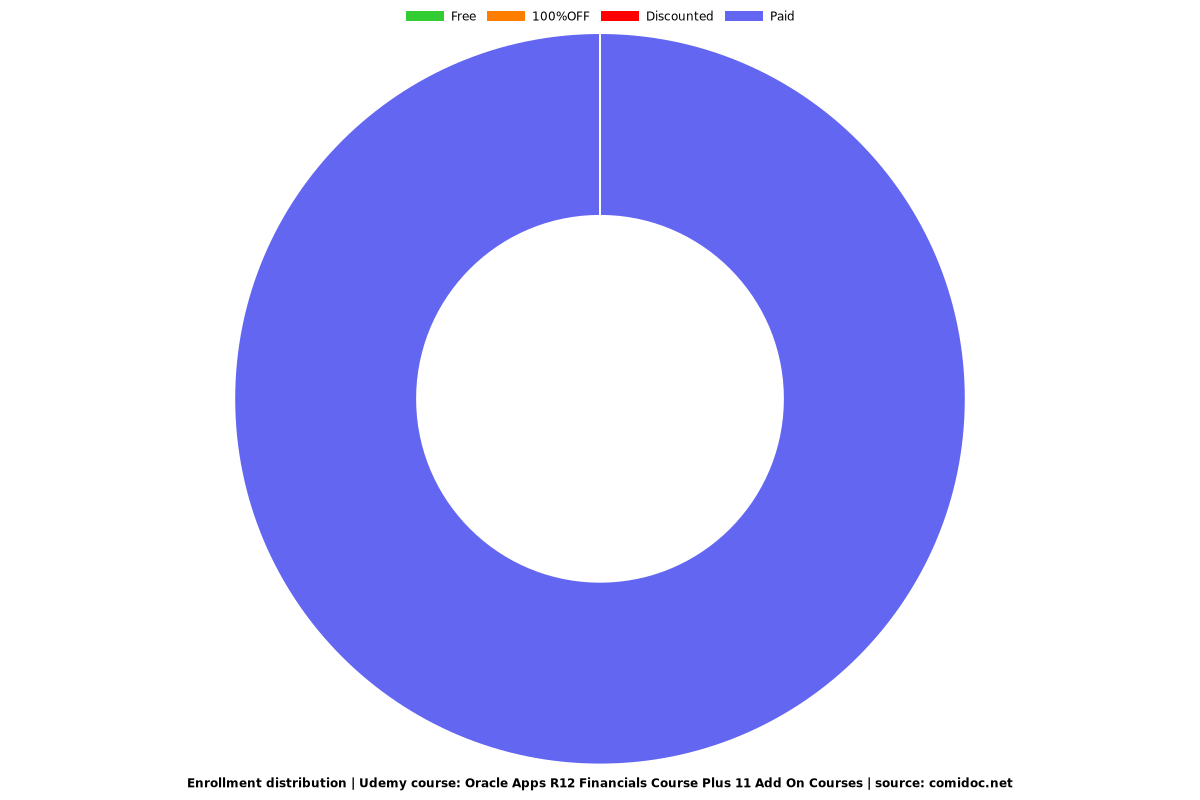Oracle Apps R12 Financials Course Plus 11 Add On Courses
Oracle Financials Online Training Videos along with 11 Additional Add On Courses (120 Hours)

What you will learn
Oracle Apps R12 Financials Course, Financials Interview Q&A Course
Oracle Apps R12 Technical Course, Technical Interview Q&A Course
Oracle Apps R12 SCM Course
Oracle Apps R12 Manufacturing Course
Oracle Apps R12 HRMS Course
Oracle SQL Course, Oracle PLSQL Course
Oracle TCA Course
Oracle AIM Course
Why take this course?
Oracle Apps R12 Financials Course Online Training Videos along with 11 Additional Add On Courses (120 Hours of Recorded Videos)
The Course Bundle Includes 11 Add On Courses
1) Oracle Apps R12 Financials Course
From this course, you get a clear idea of
Introduction to ERP, Versions in Oracle Apps, Modules in Oracle Application, What is Implementation Process, General Ledger, Introduction to GL Module, Key Flex Fields, Segments, Design Charts of Accounts, Value Sets, Define Currency and Calendar, Define Primary Ledger, Creation of Journals, Open/Close Periods, Reverse Journals, Journal Batch, Recurring Journals, Suspense Journals, Statistical Journals, Mass Allocation, Budgets, Inter-company Journals, Journal Approval Process, Tax Journals, Currency Translation, Reporting Currency, Revaluation, Consolidation, Cross Validation Rules, Standard Report (Trail Balance), FSG (Financial Statement Generator), Account Alias, Security Rules, Access Set, Purchasing overview, Financial Option, Overview of Procure to Pay Process, Purchasing Options, Requisitions, Document Types, RFQs, Quotations, Purchase Orders, Receipt Creation, Matching Options and Receipt Routing Methods, Invoice and payment creation, Account Payable's overview, Payable Options, Financial Options, Accounting Periods, Payable System Setups, Payment Terms, Distribution Sets, Defining Suppliers, Standard Invoice, Debit Memo, Credit Memo, Prepayment Invoice, Invoice Created Against PO, Introduction to Expense report, Employee Expense Reports, Withholding Tax Payment, Payment Format, Bank Creations, Bank Account Creation, Bank Branch Creation, overview of multi organization structure, business group setup, Defining Operating units, Defining Inventory organizations, Defining Sub Inventories, Account Receivables Introduction, Key Flex Fields, Sales Tax Location, Territory, Statement Cycle, System Options, Remittance to Address, Payment Terms, Introduction to Dunning Letters, Collectors, Customer Creation, Auto Cash Role Set, Customer Profile Class, Customer Bank Creation, Transaction Types, Invoice Transaction, Credit Memo, Deposit transaction, Bills receivable, Guarantee, Chargeback, transaction Sources, Receipt Classes, Receipt Sources, Creating Invoice, Applying the Receipt to Invoice, Rise the Credit memo, Creating Deposit Invoice and Applying the Deposit to Invoice, Applying the receipt, Miscellaneous Receipts, Remittance Receipts, month ending process, Fixed Assets introduction, Flex Field, System Controls, Financial Year Calendar, Values, Prorate Conversion Calendar, Depreciation Calendar, Book Controls, Depreciation Methods, Asset Categories, Changes, Additions, Create accounting, Asset Transfer, Mass Additions, Retirement, Cash Management, System Parameters, creation of new bank, creation of new branch, creation of bank account, Bank Statements and Reconciliation, Forecasting Vs Reconciliation, Bank Charges, Bank Transfer, Introduction to HRMS.
2) Oracle Apps R12 Financials Q&A Course
From this course, you get a clear idea of
How many flex fields are there in Oracle Financials
What are the benefits of flex fields
What is segment qualifier
Implication of dynamic inserts
What is key flex field qualifier
Types of key flex field qualifiers
What is short hand aliases
What is a period in oracle general ledger and types of periods
What is value set security type
What are the types of value sets
What are the cross validating rules
What is a value set and value set list types
What are the types of flex fields
Difference between key and descriptive flex fields
What are the essential components of GL primary ledger
What are concepts used during definition
How many types of conversion rates are there in general ledger
What is retained earnings account
What is the purpose of translation adjustment account
Different statuses of accounting periods
What is a adjusting period and its implication
What are the steps for creating primary ledger
Ledger options
What are the journal types
Integrating journal entries with general ledger module
Define Accounting cycle
What is accounts payable
What is the meaning of invoice
P2P cycle flow
Sample process flow for p2p cycle
Pay cycle
How many types of purchase orders and agreements are there
Difference between AP invoice and AR invoice
What is invoice
Types of invoice
Difference between standard invoice and mixed invoice
What is pre payment in AP
Types of AP invoices
Difference between debit memo and credit memo
What is invoice validation process
Explain the receipt routing methods
What are the purchasing modes in receiving
What are the different matching levels, explain them
What is payment terms and how to define payment terms
What are the different types of transaction types in receivables
3) Oracle Apps R12 Technical Course
From this course you will get a clear idea of
Types of Roles, Application Object Library, Application Development, Registration of Custom Objects, Interfaces and Conversions, Flex fields, Profiles, Value Sets, Multi-org Concepts, Functional Modules Overview, Reports and Forms in Oracle Applications and development of XML Reports.
There are incredible job opportunities for the desired aspirants with highest paid salary range. It will be a great career advantage by taking Oracle Apps Technical Course.
4) Oracle Apps R12 Technical Q&A Course
From this course you will get a clear idea of
What is ERP
What is Architecture of ERP
What are the Different Types of API'S for Customer Interface
What are the Parameters in PLSQL Stored Procedures
What are the Steps Required for Customizing the Form
What are the Steps Required for Attaching Report with Oracle Applications
What is Data Link
In which Tables the Flexfields are Stored
What is the Difference Between Key Flexfield and Descriptive Flexfield
Which Procedure should be called to enable a Descriptive Flexfield
What is the Difference between Flexfield Qualifier and Segment Qualifier
Where do the Concurrent Request Logfile and Output file go
What is Apps Schema. Differentiate Apps Schema and other Schemas
What is the Purpose of US Folder in Appl Directory
Explain Custom.pll, forms, reports, sql loader, control file
When will we use custom.pll
How do you find whether Multiorg is Installed
What are the Data Handlers
What are the Steps for Customizing the Standard Oracle Report
Difference between Bind Parameter and Lexical Parameter
How to find the Report short name for customizing the report
what is the structure of visappl
How to migrate the custom tables from 11.5.10 to r12
What is the Difference between Conversion and Interface
How to register a table and columns through backend
Explain the Functions fnd_req, submit_req
What are Cursors, where we have to use
Explain about the Report triggers
What is token
What are the Steps Required for Registering the Report into Apps
What are Security Attributes, Profiles
What are the Steps for Developing the Flexfields
What are Profile Options. At what level we setup the profile options
How can you know the form(fmb) name
What is the Relation between Responsibility, Menu and Request Group
What is a Function, Appl_top
What are the Supported Version of Forms and Reports Used for Developing an Oracle Apps Release 11i/r12
What is the responsibility, request group, dff
What is a Data Group and where we have to use
What is Responsibility
What is E Business Suite
What are Different Types of Responsibilities
What is a Template
What is the adhoc report
What is Value Set
What are the Different Validations Types
What is Multi Org Structure
What is the Maximum number of records we can display in one page in xml reports
What is Primary Ledger
How can we call standard interface program
Where can you find the release name from backend
Tell me what are the base tables in AR Module
Where do we create tables, sequence
Where do we create views, procedures and new profile options
What is Formula Column and Summary Column
TCA (Trading Community Architecture)
What is Flex Mode and Confine Mode
What is Place holder Column
What is Apps Architecture
What are the API's
Difference between Application Developer and System Administrator
Use of Triggers in Forms and Types of Triggers
What is TCA (Trading Community Architecture)
Difference Between Inbound and Outbound Interfaces
Form Personalization
What is MRC (Multiple Reporting Currency)
What are the Different Types of Interfaces
What is the Difference between Operating Unit and Inventory Organization
What is Item Validation Organization
What is XML Report. Difference between BI Publisher and XML
How do you Display the Company Logo
What is a Data Template
Name Some Business Cases in BI Reports
What is the Role of Work Flow in Oracle Applications
How We Can Download the Work Flow Files from Oracle Applications without Backend
What are the Steps Involved in Developing of Oracle Work Flow
What is Work Flow and Benefit's of Using Work Flow
What is Performer in Oracle Work Flow
Where do you Register Data and Layout Templates
What does Lexical Section Contains
How Do You Move Your Layout and Data Template Across Instances
5) Oracle Apps R12 SCM Course
From this course, you get a clear idea of
Procure to Pay Cycle Overview, Overview of Purchasing Process, Integration with other Oracle Applications, Overview of Suppliers, Supplier Information, Supplier Site Information, Defining and Maintaining Items, Item Categories, Item Attributes, Enterprise Structure, Locations, Organizations, Units of Measure and Items, Defining Locations, Inventory Organizations, Establishing Inventory Parameters, Requisition Life cycle, Requisition Structure, Creating and Maintaining, Creation of RFQs and Quotations, Request for Quotation Life cycle, Request for Quotation Life cycle Implementation, Creation of Purchase Orders, Purchase Order Types, Standard Purchase Order Elements, Blanket Purchase Agreements, Contract Purchase, Planned purchase order, Receiving Locations, Receipt Routing, Receipt Processing Methods, Creation of Blanket Purchase Agreement, Creation of Contract Purchase Agreement, Planned Purchase Order, Blind Receiving Transactions, Express Transactions, Unordered Receipts and Cascade transactions, Inventory Overview, Inventory Capabilities, Oracle Inventory Applications Integration, Integration of Oracle Inventory to Financials, Understanding the Receipt to Issue Life cycle, Understanding Receiving Inventory, Defining Inventory Organizations, Understanding the Inventory Organizations, Understanding the Structure of an Inventory Organization, Understanding Locations, Defining Locations, Difference between Master and Child Organization, Units of Measure Overview, Units of Measure Class Overview, Defining Unit of Measure Class, Defining Unit of Measure, Defining Unit of Measure Conversions, Defining and Maintaining Items, Item Attributes and Statuses, Assigning Items to Organizations, Sub inventories, Defining Subinventory, Inventory Controls, Concepts, Explaining Lot Control (Item Level), Lot Control (Org Level), Explaining Serial Control (Item Level), Explaining Serial Control (Org Level), Explaining Revision Control, Explaining Locator Control, Subinventory Transfers, Explaining Move Order, Creating Manual Move Order, Creating Requisition Move Order, Requisition Move Order Approval Process, Transact Move Orders with 2 Methods, Miscellaneous Transactions, Restrict Subinventories, Inter-Org Transfer, Shipping Methods, Shipping Network, Transit times for Shipping Methods, Entering inter-org transfer charge, Entering Freight Charges, Direct Inter-Organisation Transfer, Performing Reorder-point Planning, Performing Min-max Planning, Explaining Cycle Counting, Explaining Physical Inventory, Defining and Maintaining a Cycle Count, Defining Cycle Count Scheduling and Requests, Overview of Oracle Order Management, Order to Cash Life cycle Overview, Ordering Process, Inventory Organizations, Define Shipping Parameters, Customer Creation, Auto Cash Role Set, Customer Profile Class, Customer Bank Creation, Transaction Types, Transaction Sources, Creating Invoice, Creating Deposit Invoice and Applying the Deposit to Invoice, Enter Orders, Managing Order, Drop Shipment Implementation, Back to Back Order Implementation, Pick Release Sales Orders, Ship Confirm a Delivery, Define a Pick Slip Grouping Rule, Define a Release Sequence Rules, Order Management Transaction Setups, Defining Order Transaction Type, Defining Line Transaction Type, Defining Document Sequence, Return Material Authorization, Return With Credit No Receipt, Return With Receipt Only, Return With Receipt, Credit Auto Invoice, Internal Sales Order Implementation..
6) Oracle Apps R12 Manufacturing Course
From this course, you will get a clear idea of
Introduction to Oracle Apps R12 Manufacturing, Introduction to Oracle Applications, Versions, Multi Org Structure, Introduction to P2P and O2C Cycles, Inventory Overview, Inventory Capabilities, Oracle Inventory Applications Integration, Integration of Oracle Inventory to Financials Applications, Understanding the Receipt to Issue Life cycle, Understanding Receiving Inventory, Defining Inventory Organizations, Understanding the Inventory Organizations, Units of Measure Overview, Units of Measure Class Overview, Defining Unit of Measure Class, Defining Unit of Measure, Defining Unit of Measure Conversions, Defining and Maintaining Items, Item Attributes and Statuses, Assigning Items to Organizations, Subinventory Overview, Defining Subinventory, Inventory Controls, Explaining Lot Control(Item Level), Lot Control (Org Level), Explaining Serial Control (Item Level), Explaining Serial Control (Org Level), Explaining Revision Control, Explaining Locator Control, Subinventory Transfers, Explaining Move Order, Creating Manual Move Order, Creating Requisition Move Order, Requisition Move Order Approval Process, Transact Move Orders with two Methods, Miscellaneous Transactions, Restrict Subinventories, Inter-Org Transfer, Shipping Methods, Shipping Network, Transit times for Shipping Methods, Entering inter-org transfer Charges, Entering Freight Charges, Direct Inter-Organisation Transfer, Performing Reorder-point Planning, Performing Min-max Planning, Explaining Cycle Counting, Explaining Physical Inventory, Defining and Maintaining a Cycle Count, Defining Cycle Count Scheduling and Requests, Introduction about BOM, BOM parameters, Resource Groups, Department Class, Creation of items and assign cost to item, Overheads and Routings, Define Discrete jobs, Define Bills, Types of Bills, Option Class Bill and Where we use item in BOM, Bill Comparison, Where we use resource in bill, Setup of Alternative bills, Introduction to WIP, WIP Parameters, WIP Accounting Class, Schedule groups, Supply Types, Supply Type Push, Supply Type Operation Pull, Supply Type Assemble Pull, Supply Type Bulk, Supply Type Panthom, OSP.
7) Oracle Apps R12 HRMS Course
From this course you will get an idea of
Oracle R12 HRMS Fundamentals
Oracle R12 Core HR
Oracle R12 Payroll
Oracle R12 Absence Management
Oracle R12 SSHR
8) Oracle SQL Course
From this course you will get a clear idea of
Introduction to RDBMS, Introduction to SQL, Oracle data types, classification of sql, DDL and DML Commands, DDL and DML Commands Continued, Integrity Constraints, SQL Functions, Character Functions, Number Functions, SQL Functions Continued, Date Functions, Group Functions, Joins, Sub Queries and Clauses, Database Objects, Database Objects Continued, DCL and TCL Commands
9) Oracle PLSQL Course
From this course you will get a clear idea of
Introduction to PL/SQL, Data Types and PLSQL Blocks, Looping Structures, Looping Structure While and Nested Loops, Looping Structure Continuation, Conditional Statements, Cursors, Exceptions, Exceptions continued, Procedures, Functions, Packages.
10) Oracle D2K (Forms and Reports) Course
From this course you will get a clear idea of
Forms 10g and Role in Oracle Apps, Fundamentals of D2K, Creation of Data blocks Through wizard and Manually, Creation of Different Types of Canvases and Working with Canvases, Types of windows and working with windows and changing windows properties, Different types of Triggers, Working with Triggers and Applying to Different Controls, Creation of alerts and Calling of Alerts Changing Properties at runtime and Re-using Alerts, Creation of Editors, Types of Editors and Calling editors through Code, Creating and Using Object Groups . Creating and Using Object Libraries, Creation of Lov through wizard and Manually, Working with Lov Properties, Creation of Record Groups Based On Query and Using Static Values, Creation of Master-Detail Data Blocks, Parameters, Creation of Menus and attaching menus to Forms, Working with Procedures, Functions and Packages in Forms, Usage of PL/SQL Libraries in Forms and Attached Libraries, Reports 10g, Introduction to Reports, Fundamentals of Reports, Advantages, Features and role of Reports in D2K, Creation of Different types of Reports, Creation of Reports with different Parameters, User Parameters, System Parameters, Working with Formula Columns, Working with Summary Columns, Working with Place Holder Columns, Working with Data links, Developing Reports Manually, Reports in Triggers, Creation of Layout in Reports, Drill Down Reports, Calling Reports from Forms, Calling Reports from Reports.
11) Oracle TCA Course
This Course includes What is TCA, TCA Matters Before and After, TCA Data Model Components, TCA in R12 Includes, TCA in R12 MOAC, TCA in R12 Bank Account Model, TCA in R12 Legal Entities, TCA API's, TCA Tables.
12) Oracle AIM Course
This Course Covers AIM Introduction, Project Types, Types of Server Instances, Project Phases, Data Conversion Strategies, Documents in AIM, Support Project Process, Period Close Process, Issue Priorities and Ticket Statuses
Reviews
Charts
Price

Rating

Enrollment distribution
